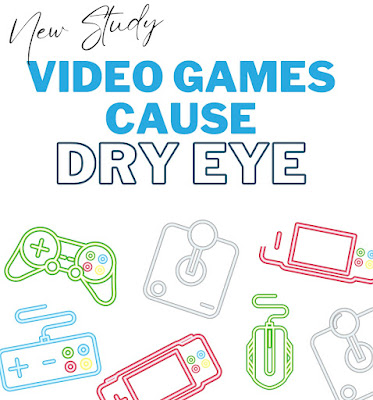Yes America, Playing Video Games Does Cause Dry Eye
1:40 PMBurning, red, and watery eyes: that's what I've always experienced just a short time into video game play. And with 27% of Americans playing video games at least a few hours each week, it's no surprise that dry eye syndrome is increasingly prevalent across all ages. Newly published research has confirmed what many eye doctors hypothesized to be true: video game play does result in dry eye, even among young and healthy individuals.
The study evaluated 41 college students who played video games over a 4 hour time window, with a 5 minute break every hour and fluid intake of "no more than" 2 cups during that time frame. All study participants played the game within a dedicated lab room which was monitored for consistent temperature and humidity to make sure that was not a confounding factor. Dry eye tests were performed before video game play and after; these tests included SPEED and OSDI questionnaires, Snellen Visual Acuity at distance and near, Tear Film Osmolarity (Tear Lab), Schirmer test without anesthesia, and Matrix-Metalloproteinase-9 (MMP-9) levels (Quidel).
At the end of the 4 hours of video game play, there was a statistically significant worsening in SPEED score index and MMP-9 levels for participants. The average SPEED score for participants nearly doubled at the end of the gaming window, with average soreness and irritation increasing 3x compared to baseline, and the frequency and severity of eye fatigue complaints doubling compared to baseline. Of the participants who had normal MMP-9 levels before gaming, 36% of participants had elevated levels after gaming. MMP-9 is an inflammatory biomarker found in the tear film that is elevated in patients with dry eye syndrome.
This is the first known study to prove that video game play specifically causes dry eye symptoms. Based on the 36% of participants who had changes in their MMP-9 levels after game play, in some individuals video game play can even trigger inflammatory changes to the eye. Because dry eye syndrome is so multi-factorial, it's important to understand the environmental situations that create more risk for your eyes so that if you suffer from chronic or severe dry eye syndrome you can appropriately modify your exposure to these high risk environments. The Tear Film and Ocular Surface Society Lifestyle Report identified environment and lifestyle as major contributors to dry eye/ocular surface disease - with windy environments, higher levels of air pollution, and digital screen use all being identified as exacerbating factors. Check out the full TFOS Lifestyle Report to learn more.
















0 comments